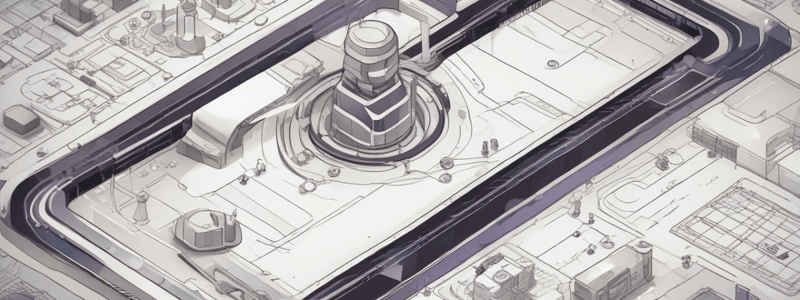Podcast
Questions and Answers
What is the primary focus of Business Process Reengineering (BPR)?
What is the primary focus of Business Process Reengineering (BPR)?
- Optimizing individual tasks
- Downsizing the workforce
- Implementing new technologies
- Optimizing end-to-end processes (correct)
What is a key feature of business processes?
What is a key feature of business processes?
- They are only concerned with cost reduction
- They are static and unchanging
- They are limited to one department
- They have clients that transcend organizational boundaries (correct)
What can be a result of successful BPR implementation?
What can be a result of successful BPR implementation?
- Enormous reductions in cost or cycle time (correct)
- Decreased customer satisfaction
- Increased cycle time
- Higher employee turnover
What percentage of BPR initiatives are likely to fail?
What percentage of BPR initiatives are likely to fail?
What is BPR a type of?
What is BPR a type of?
What is a potential challenge during the implementation of Business Process Re-engineering (BPR) initiatives?
What is a potential challenge during the implementation of Business Process Re-engineering (BPR) initiatives?
What is a primary benefit of Business Process Re-engineering (BPR)?
What is a primary benefit of Business Process Re-engineering (BPR)?
What is an outcome of successful Business Process Re-engineering (BPR) initiatives?
What is an outcome of successful Business Process Re-engineering (BPR) initiatives?
Why is Business Process Re-engineering (BPR) crucial for organizations?
Why is Business Process Re-engineering (BPR) crucial for organizations?
What is an aspect of Business Process Re-engineering (BPR) that promotes organizational flexibility?
What is an aspect of Business Process Re-engineering (BPR) that promotes organizational flexibility?
What is a major challenge that organizations face when trying to implement BPR?
What is a major challenge that organizations face when trying to implement BPR?
What is the primary goal of re-engineering?
What is the primary goal of re-engineering?
What is a key difference between BPR and Total Quality Management (TQM)?
What is a key difference between BPR and Total Quality Management (TQM)?
What is a benefit of Business Process Re-engineering (BPR)?
What is a benefit of Business Process Re-engineering (BPR)?
What is a result of implementing BPR?
What is a result of implementing BPR?
What is a potential outcome of streamlined and efficient workflows?
What is a potential outcome of streamlined and efficient workflows?
What is a major challenge of Business Process Re-engineering (BPR)?
What is a major challenge of Business Process Re-engineering (BPR)?
What is a potential risk of implementing new technologies during BPR?
What is a potential risk of implementing new technologies during BPR?
What can be a result of inadequate planning and lack of clear objectives during BPR?
What can be a result of inadequate planning and lack of clear objectives during BPR?
What can occur during the transition period of BPR implementation?
What can occur during the transition period of BPR implementation?
What is the main benefit of achieving strategic alignment through Business Process Re-engineering?
What is the main benefit of achieving strategic alignment through Business Process Re-engineering?
What is the first step in the Business Process Re-engineering process?
What is the first step in the Business Process Re-engineering process?
What is the purpose of process mapping and flowcharting in BPR?
What is the purpose of process mapping and flowcharting in BPR?
What is the outcome of a well-planned transition plan in BPR?
What is the outcome of a well-planned transition plan in BPR?
What is the cultural shift encouraged by Business Process Re-engineering?
What is the cultural shift encouraged by Business Process Re-engineering?
What is the primary goal of establishing key performance indicators (KPIs) in a re-engineered process?
What is the primary goal of establishing key performance indicators (KPIs) in a re-engineered process?
What is a characteristic of organizational re-engineering?
What is a characteristic of organizational re-engineering?
What is a misconception about Business Process Re-engineering (BPR)?
What is a misconception about Business Process Re-engineering (BPR)?
What is critical to the success of a re-engineered process?
What is critical to the success of a re-engineered process?
What is a key aspect of Business Process Re-engineering (BPR)?
What is a key aspect of Business Process Re-engineering (BPR)?
What is the main objective of Business Process Reengineering (BPR)?
What is the main objective of Business Process Reengineering (BPR)?
What is a characteristic of Business Process Reengineering (BPR)?
What is a characteristic of Business Process Reengineering (BPR)?
What is the relationship between Business Process Reengineering (BPR) and organizational strategy?
What is the relationship between Business Process Reengineering (BPR) and organizational strategy?
What is the primary goal of Business Process Reengineering (BPR)?
What is the primary goal of Business Process Reengineering (BPR)?
What is an outcome of successful Business Process Reengineering (BPR)?
What is an outcome of successful Business Process Reengineering (BPR)?
What is a key aspect of Business Process Reengineering (BPR)?
What is a key aspect of Business Process Reengineering (BPR)?
What is the focus of Business Process Reengineering (BPR)?
What is the focus of Business Process Reengineering (BPR)?
What is a characteristic of successful Business Process Reengineering (BPR)?
What is a characteristic of successful Business Process Reengineering (BPR)?
What is the relationship between Business Process Reengineering (BPR) and organizational competitiveness?
What is the relationship between Business Process Reengineering (BPR) and organizational competitiveness?
What is the outcome of successful Business Process Reengineering (BPR) initiatives?
What is the outcome of successful Business Process Reengineering (BPR) initiatives?
Flashcards are hidden until you start studying
Study Notes
Business Process Re-engineering (BPR)
- BPR is the radical redesign of business processes to achieve dramatic improvements in performance, efficiency, and effectiveness.
- It focuses on optimizing end-to-end processes and eliminating redundancies.
- BPR is a continuous journey of innovation and optimization, not a one-time project.
Definition of Re-engineering
- Re-engineering refers to the systematic process of rethinking and redesigning workflows and processes within an organization.
- The goal is to achieve significant improvements in critical performance metrics such as cost, quality, service, and speed.
Definition of Business Process Re-engineering
- BPR is a methodology that can be used to drastically alter or replace a business process in its entirety.
- It has a substantial impact beyond organizational borders, affecting external suppliers and customers.
Advantages of BPR
- Cost Reduction: elimination of redundancies and efficient resource utilization.
- Improved Efficiency: streamlined workflows and automation of repetitive tasks.
- Enhanced Quality: error reduction and standardization of processes.
- Better Customer Service: faster response times and customized services.
- Greater Flexibility: adaptability to change and scalability.
- Enhanced Competitive Advantage: market differentiation, innovation, and employee satisfaction.
- Increased Productivity: faster turnaround and higher output.
- Better Alignment with Business Goals: strategic focus and goal achievement.
- Risk Management: reduced operational risks and improved compliance.
Disadvantages/Limitations of BPR
- Organization Resistance: resistance to change within the organization.
- High Initial Costs: significant investment in new technologies and training programs.
- Risk of Implementation Failure: risk of not achieving anticipated benefits.
- Human Factors: implications for employees, including job role changes and potential job losses.
- Overemphasis on Technology: ignoring human and organizational factors.
- Short-term Disruption: temporary declines in efficiency and productivity.
- Cultural Misalignment: clash with existing organizational culture.
Importance and Benefits of BPR
- Cost Reduction: significant reduction in operational costs.
- Efficiency Improvements: faster turnaround times and increased productivity.
- Quality Enhancement: higher quality products and services.
- Customer Service Improvements: faster response times and customized services.
- Greater Flexibility: adaptability to change and scalability.
- Strategic Alignment: alignment with organizational goals and objectives.
- Culture of Continuous Improvement: fostering innovation and continuous improvement.
Steps Involved in BPR
- Develop a Business Vision and Objectives: establish clear understanding of organizational goals and objectives.
- Identify Business Processes to be Re-engineered: select key processes with significant impact on performance.
- Understand and Analyze Existing Processes: document and analyze current workflows.
- Identify Change Levers and Enablers: identify key factors driving change and enabling new processes.
- Design the New Process: develop detailed process models and prototypes.
- Develop a Transition Plan: plan for implementing new processes and managing change.
- Implement the Re-engineered Process: roll out new processes and deploy new technologies.
- Monitor and Evaluate the New Process: continuous monitoring and evaluation to ensure success.
- Continuous Improvement: foster a culture of ongoing improvement and refinement.
Organizational Re-engineering
- Fundamental Rethinking: question existing assumptions and practices to identify fundamental flaws.
- Radical Redesign: create entirely new ways of doing things to achieve breakthrough improvements.
- Dramatic Improvements: achieve significant performance improvements in areas such as cost reduction, quality enhancement, and customer satisfaction.### Re-engineering Benefits
- Re-engineering aims to deliver substantial, measurable benefits.
What Re-engineering is Not
- Re-engineering is not about making small adjustments or incremental improvements to existing processes, but rather a complete rethinking and restructuring of how work is done.
- It is not a quick fix for immediate problems or a short-term solution, but rather a strategic initiative aimed at achieving long-lasting improvements in efficiency, quality, and competitiveness.
- Re-engineering involves more than just adopting new technologies, but aligning technology with redesigned processes to achieve strategic goals.
- It also addresses human factors such as organizational culture, employee skills, and change management.
- There is no one-size-fits-all approach to re-engineering; it requires customization and adaptation to fit the specific context, goals, and challenges of each organization.
- Re-engineering is not solely a cost-cutting exercise, but aims to improve overall organizational performance across multiple dimensions, including quality, speed, customer satisfaction, and innovation.
- It is an ongoing process of continuous improvement and adaptation to changing business environments.
- Re-engineering is closely aligned with the strategic objectives and vision of the organization, and is driven by strategic goals to enhance the organization's ability to achieve its long-term vision.
Studying That Suits You
Use AI to generate personalized quizzes and flashcards to suit your learning preferences.





